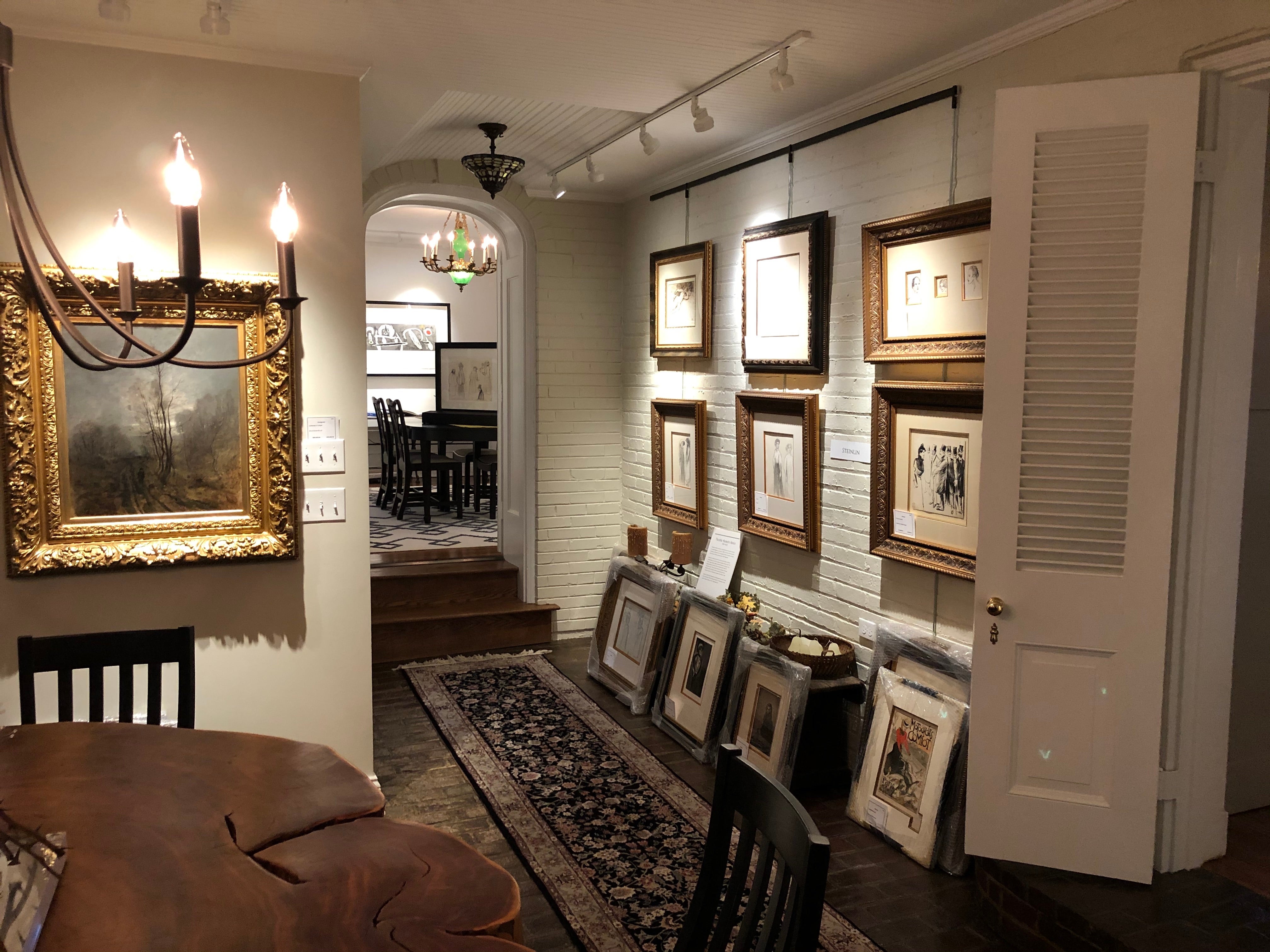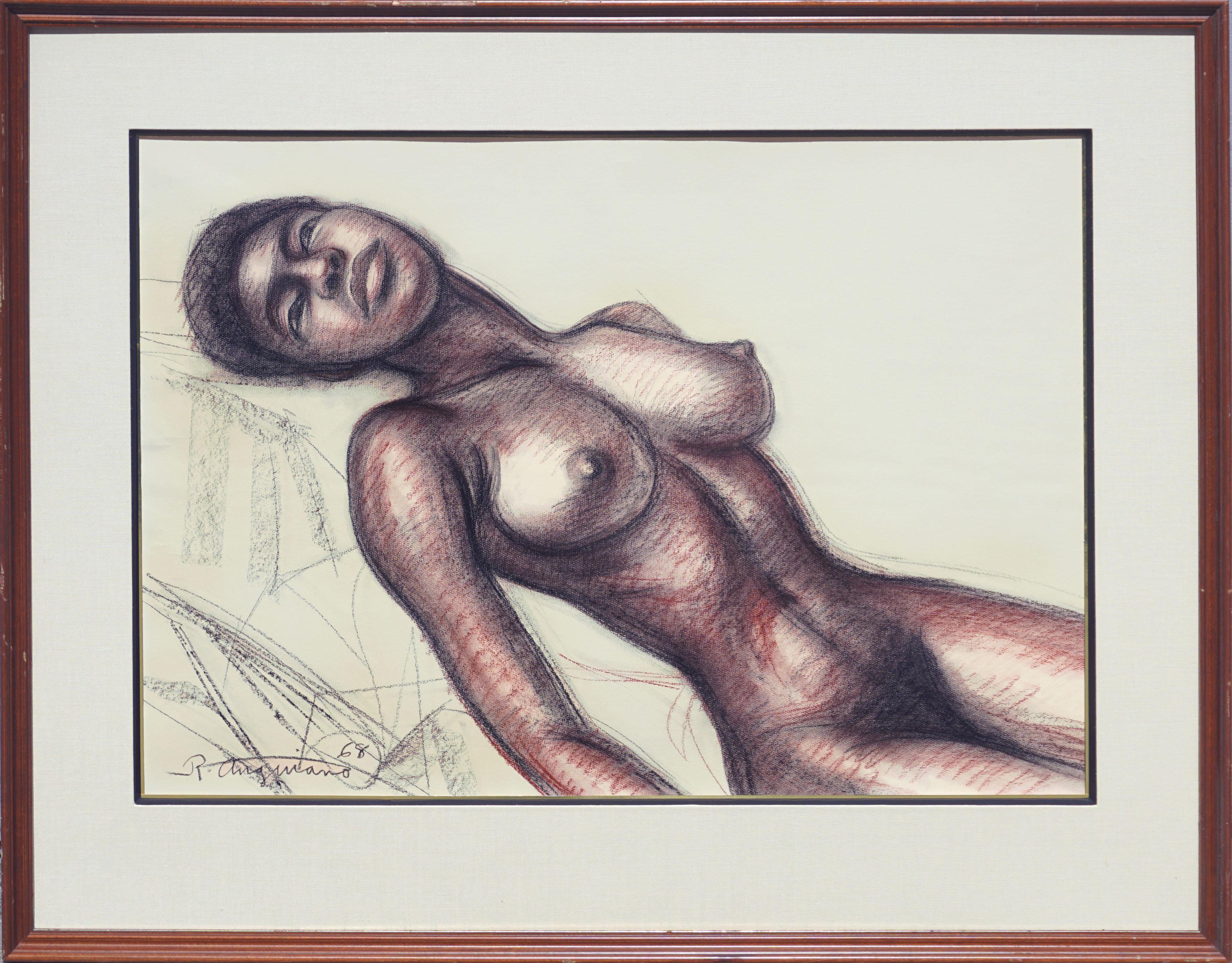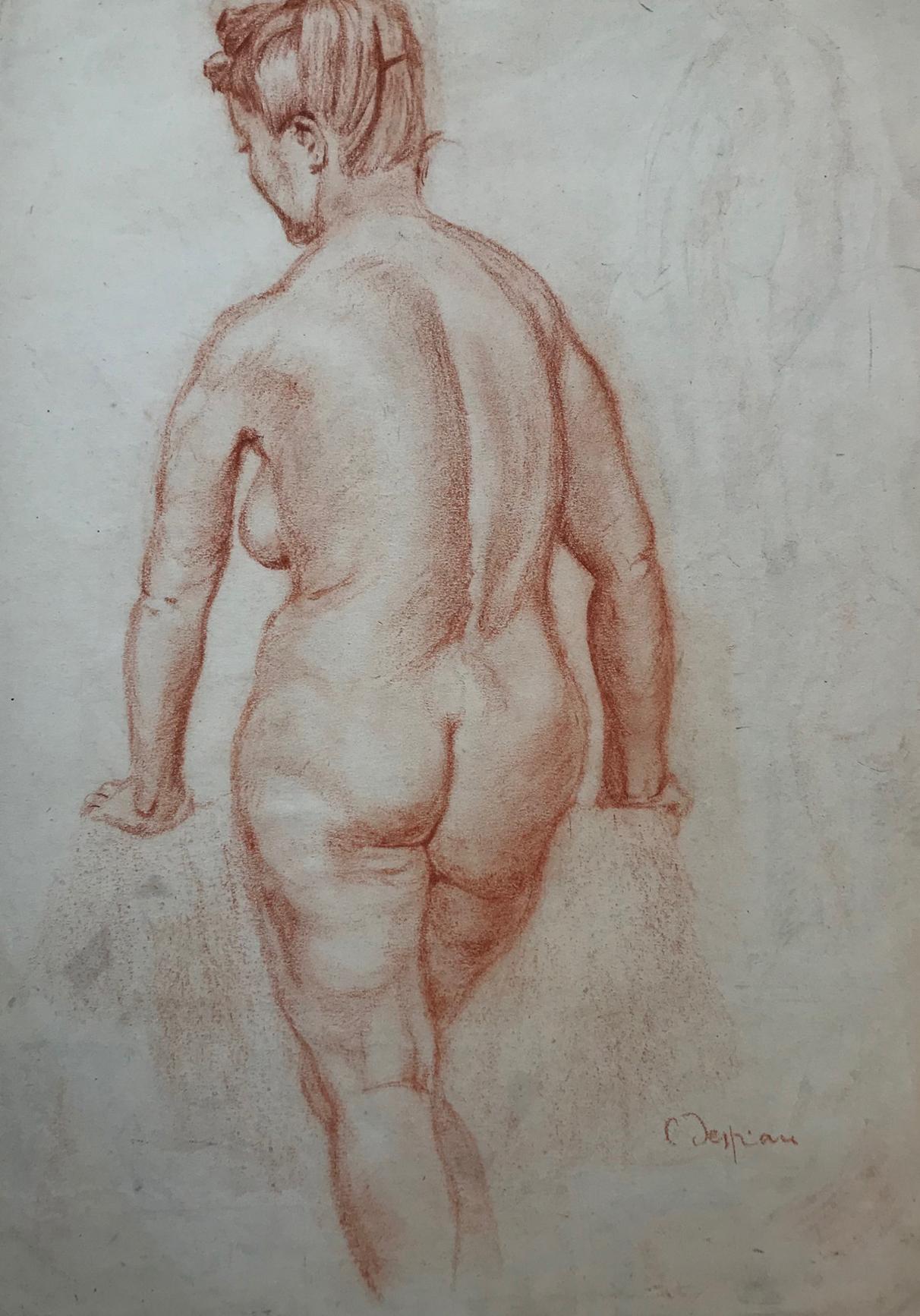Items Similar to Original Drawing "Jeune Femme Assise" by Paul Cesar Helleu, c. 1910
Want more images or videos?
Request additional images or videos from the seller
1 of 10
Paul César HelleuOriginal Drawing "Jeune Femme Assise" by Paul Cesar Helleu, c. 19101910
1910
About the Item
HELLEU, PAUL CÉSAR
(1859 -1927)
"JEUNE FEMME ASSISE"
(Young Woman Seated)
Original Drawing in sanguine, white and black chalks, c. 1910
Signed in pencil by artist, lower right
Full Margins on cream wove paperImage size: 17.5” x 11.02”
Paul César Helleu was born in Vannes, France in 1859. As a young boy he immediately took a passionate interest in art. His father died when Paul César was still young and his mother was not keen on her son following the unstable profession of an artist. Helleu was however, a determined young man and by the age of seventeen he had moved to Paris to study at the Ecole des Beaux Arts. Helleu rejected the classical academic approach to painting that he was taught at art school and instead embraced Impressionism. Helleu formed close friendships with Degas, Rodin, Renoir and particularly Monet who became a close friend and companion. Helleu’s closest friend was John Singer Sargent and it was he who inspired Helleu to become a portraitist. In 1884, Helleu was invited by Monsieur and Madame Guérin to execute a portrait of their fourteen year old daughter Alice -Helleu immediately fell madly in love with her. In 1886 they were married, Alice being only sixteen years old. During the early 1890s, Helleu and his young wife were popular figures in the aristocratic circles frequented by the élite of European society. Helleu forged friendships with many of the greatest authors of the time. Marcel Proust held Helleu in high regard and used him as a model for the artist Elistir in his epic work, A la recherche du temps perdu. Helleu adored the company of beautiful women and was introduced to many elegant, fashionable women who became principle sitters for his portraits. Helleu’s wife Alice was undoubtedly his favorite model, she was charming, refined and graceful and his portraits of her are drawn with intimate sensitivity.
- Creator:Paul César Helleu (1859-1927, French)
- Creation Year:1910
- Dimensions:Height: 32.25 in (81.92 cm)Width: 25.5 in (64.77 cm)Depth: 3 in (7.62 cm)
- More Editions & Sizes:One of a kindPrice: $39,500
- Medium:
- Movement & Style:
- Period:
- Condition:
- Gallery Location:Hinsdale, IL
- Reference Number:

About the Seller
5.0
Vetted Seller
These experienced sellers undergo a comprehensive evaluation by our team of in-house experts.
Established in 1994
1stDibs seller since 2020
37 sales on 1stDibs
- ShippingRetrieving quote...Ships From: Hinsdale, IL
- Return PolicyA return for this item may be initiated within 14 days of delivery.
More From This SellerView All
- Original ink drawings "Trois Portraits" by SteinlenBy Théophile Alexandre SteinlenLocated in Hinsdale, ILSTEINLEN, THEOPHILE ALEXANDRE (1859 -1923) "Trois Portraits" (Three Portraits) Original ink drawings, c. 1900 Initialed in ink by the artist Bears artist monogram stamp in black in...Category
Early 19th Century Art Nouveau Figurative Drawings and Watercolors
MaterialsPen
- "Femme au cep de vigne, 4th var." (Woman by the Grape Vine, 4th variant)By Pierre-Auguste RenoirLocated in Hinsdale, ILRENOIR, PIERRE AUGUSTE (1841 -1919) "Femme au cep de vigne, 4th variante" Woman by the Grape Vine, 4th variant Delteil 48, Stella 48 Original lithograph in black ink, 1904 -1905 On...Category
Early 20th Century Impressionist Figurative Prints
MaterialsLithograph
- "Le Portique de la Galerie Nationale a Londres" etching by TissotBy James Jacques Joseph TissotLocated in Hinsdale, ILTISSOT, JAMES JACQUES JOSEPH (1836 - 1902) "Le Portique de la Galerie Nationale a Londres" (The Portico of the National Gallery, London) Wentworth 40 Etching and Drypoint on imitation Japanese paper, C. 1878 Only state published, from the edition of 100 Signed 1878 J.J. Tissot on the step, lower right 14 7/8” x 8 1/4” Excellent crisp impression This etching is related to the painting London Visitors exhibited at the Royal Academy in 1874, no. 116. The setting is the portico of the National Gallery, looking toward the Church of St. Martin’s-in-the-Fields. Such works give Tissot a minor but distinguished position as a predecessor of the school of architectural etchers...Category
Late 19th Century Impressionist Figurative Prints
MaterialsEtching
- "Une Mère et Enfant (Jean Renoir)"By Pierre-Auguste RenoirLocated in Hinsdale, ILRENOIR, PIERRE AUGUSTE (1841 -1919) "Une Mère et Enfant (Jean Renoir)" (Mother and Child) Delteil 10, Stella 10 Drypoint in color, 1896 Proof aside from the numbered edition of 100 impressions Published in “L’Album des peintres-graveurs; Ambroise Vollard Signature on the stone “Renoir” 10” x 7 3/4” Very fine impression on laid paper Renoir’s interest in the mother and child theme was awakened with the birth of his first son Pierre in 1885. In 1894 their second son, Jean, was born. This was the inspiration for this particular etching created when Jean was just two years old. Renoir was interested in Rubens and Delacroix’s rich use of color and loose rounded form which he observed in the Louvre in Paris. His appreciation is evident in this printThe simple positioning of the figures is structurally balanced, and shows Renoir looking back to Raphael’s Virgin and Child paintings...Category
1880s Impressionist Portrait Prints
MaterialsEtching
- "La Vache Enragee" iconic vintage poster by Toulouse-LautrecBy Henri de Toulouse-LautrecLocated in Hinsdale, ILTOULOUSE-LAUTREC, HENRI DE (1864-1901) "LA VACHE ENRAGÉE" Wittrock P27B, Adhemar 197 Original color lithograph Wittrock’s State III of III with letters Printed on buff wove paper, c. 1896 Bears artist stamp “TL” upper right, dated 96 Image size: 22 1/2” x 23 5/8” Several examples are known where Lautrec drew on work by other artists whom he admired. In this poster there are clear references to Adolphe Willette's humorous themes and rococo style of illustration. Willette was the founder and illustrator of the short-lived monthly “La Vache Enragee”(the angry cow) edited by the cartoonist Adolphe Roedel. This colored poster of the same title was commissioned for the appearance of the magazine March 1896. As a reference to the wretched financial state of most artists, the term “manger de la vache enrage” (meaning roughly, “meaning not having enough to eat”) was adopted as the motto for the “Vachalcade”which was held on Montmarte annually from 1896. This was an artists' procession, with fanfares and allegories on fame and the muses; it also included a furious cow and a troupe of pretty girls as a satire on Europa with the bull. The event was organized by Roedel"(Adriani p.217) Toulouse-Lautrec took up lithography at a high point in its history, when technical advances in color printing and new possibilities for large scale led to a proliferation of posters as well as prints for the new bourgeois collector. In his short career, he created more than three hundred fifty prints and thirty posters, as well as lithographed theater programs...Category
1890s Art Nouveau Figurative Prints
MaterialsLithograph
- F-111 (Castelli Gallery Poster)By James RosenquistLocated in Hinsdale, ILROSENQUIST, JAMES (1933 - 2017) F-111 (Castelli Gallery Poster) Offset Lithograph c. 1965 Signed and dated in pencil along lower edge Sheet Size: 28” x 22”, Fresh ...Category
1960s Pop Art Abstract Prints
MaterialsLithograph, Offset
You May Also Like
- Vintage Figurative Landscape -- Sleeping Among the TreesLocated in Soquel, CACompelling figurative nude with a surrealist feel by Ken Bower (American, 20th-C) a San Francisco Bay area artist. Pastel chalk color on paper created in 1980. Signed “Ken Bower 80' ...Category
1980s American Impressionist Nude Drawings and Watercolors
MaterialsPaper, Chalk, Pastel
- Mid Century Nude Figure Study of a Black WomanBy Raul AnguianoLocated in Soquel, CACompelling mid century nude figure study of a black woman reclining by Raul Anguiano (Mexican/American, 1915-2006), 1968. Signed and dated lower left hand corner "R. Anguiano." Presented in wood frame under plexiglass. Image size: 25"H x 34"W. Framed size: 35"H x 43.75"W. Raúl Anguiano was born in Guadalajara, Jalisco, on February 26th, 1915. He started drawing cubist pictures at the age of 5, taking as his first models movie stars, as Mary Pickford, Pola Negri and Charlie Chaplin. Anguiano first artistic influence or aesthetic emotion came from the Holy Family by Rafael Sanzio. At the age of 12, Anguiano attended Guadalajara's Free School of Painting under the tuition of Ixca Farias. From 1928 to 1933, he studied with the Master painter José Vizcarra, the disciple of Santiago Rebull and José Salomé Piña, and organised the group "Young Painters of Jalisco" with other artists. During this period, Anguiano worked with different kinds of models: workmen, employees and a few intellectuals like Pita Amor. In 1934 Anguiano moved to Mexico City. He began teaching in primary schools and taught drawing and painting at La Esmeralda academy and the UNAM School of Art. Anguiano was a member of the Mexican Artistic Renaissance movement which was started in the 1920's by the Mexican School of Art in which he belonged. This renaissance began with the San Carlos Academy movement -- among whose leaders were Ignacio Asúnsolo and Jose Clemente Orozco -- and which emerged out of the students' and teachers' discontent with the traditional paintings methods (academicism), and the close contact that the young artists had with the problems of Mexico and its people, explaining the marked critical realism to the painters of the time, including Anguiano himself. The same year, Anguiano received a commission to paint his first mural, Socialist Education, a 70 meters fresco located at A. Carrillo School in Mexico City. Other works followed, including Mayan rituals (oils on canvas and wood), for the Mayan Hall in the National Museum of Anthropology, and Trilogy of Nationality (acrylic on canvas and wood), for the Attorney General's Office. In 1936 he moved into his surrealist period, which lasted almost a decade. He painted circus performers and prostitutes. The most notable among his works of the time are: The Madame (gouche, 1936), The Clown's Daughter (oil, 1940), the Pink Circus Artist and the Grey Circus Artist (oil, 1941). Also during this period, Anguiano produced a series of drawings based on his dreams, with cold tones and silver-greys predominating. In 1937 Anguiano joined the Revolutionary Writers and Artists League. Together, with Alfredo Zalce and Pablo O'Higgins, he was also a founding member of the Popular Graphics Workshop, where artists practised a graphic style based on Mexico's folk traditions. This was due to the powerful influence of the recently discovered Jose Guadalupe Posada and Goya. Raúl Anguiano belonged to the so-called "Third Generation" of post-revolutionary painters, along with Juan O'Gorman, Jorge González Camarena...Category
1960s American Impressionist Nude Paintings
MaterialsPaper, Conté, Charcoal
- Seated Woman Figurative PortraitBy Doris WarnerLocated in Soquel, CAVintage watercolor portrait of a seated female figure with red robe in front of a plant by Doris Ann Warner (American, 1925-2010). Signed "Warner" in the lower left corner. Presented...Category
1970s American Impressionist Figurative Drawings and Watercolors
MaterialsPaper, Conté, Watercolor
- Portrait of George Arliss in Conte Crayon on Cardstock 1934Located in Soquel, CAStately portrait of George Arliss by Ivan Opffer (Danish, 1897-1980). Mr. Arliss is depicted wearing his signature monocle, looking directly at the viewer. Although this piece appears to be done rapidly, there is a clear confidence in Opffer's work - he was an accomplished portrait artist - and the resemblance to the subject is unmistakable. George Arliss (born Augustus George Andrews; 10 April 1868 – 5 February 1946) was an English actor, author, playwright, and filmmaker who found success in the United States. He was the first British actor to win an Academy Award – which he won for his performance as Victorian-era British prime minister Benjamin Disraeli in Disraeli (1929) – as well as the earliest-born actor to win the honour. He specialized in successful biopics, such as Disraeli, Voltaire (1933), and Cardinal Richelieu (1935), as well as light comedies, which included The Millionaire (1931) and A Successful Calamity (1932). Signed and dated "Ivan Opffer 1934" in the lower right. Titled "Mr. Arliss" in the lower left. Presented in a new off-white mat with foamcore backing. Mat size: 22"H x 16"W Art size: 17.5"H x 12"W Ivan Opffer (Danish, 1897-1980) was born in Nyborg, Denmark, on June 4, 1897, to a family of Danish scholars and journalists. His brother was Emil Opffer, a Danish merchant seaman and journalist who was known for his relationship with American writer Hart Crane. Ivan was raised in Mexico City and New York, where his anarchist father was the editor of a radical Danish-language newspaper. His involvement in painting and drawing began at an early age. At a summer workshop, he met and studied drawing with Winslow Homer, then went on to study at the National Academy of Design and the Art Students League of New York. When the US entered World War I, Opffer was one of the members of the American Army Camouflage Corps, headed by Homer Saint-Gaudens (whose mother was a relative of Winslow Homer), the son of Augustus Saint-Gaudens. As a camoufleur, Opffer served with other artists and architects, some of whom became well-known, including Barry Faulkner, Sherry Edmundson Fry, Kimon Nicolaides, Robert Lawson, Abraham Rattner, Kerr Eby, and others. It was this same unit, while still in training in at Camp American University in Washington DC, that launched a camp newspaper called The Camoufleur. Only three issues were published before the unit’s deployment to France in late 1917. In the October 31 issue, a satirical portrait by Opffer of Homer Saint-Gaudens (titled “Our Boss”) was published on page 5. After the war, Opffer returned to New York, where he became known for his caricatures of leading Modern writers, among them James Joyce, Edgar Lee Masters, Siegfried Sassoon, George Bernard Shaw, Carl Sandburg, G.K. Chesterton, and Thomas Mann. In the years between the wars, Opffer married Betty à Beckett Chomley, and settled in Paris, where he was a student at the Academie Julliard. He also lived in London and Copenhagen, where his drawings were frequently published in newspapers and magazines. With the outbreak of World War II, he and his family returned to New York and lived in Greenwich Village. Among his friends in that era were William Butler Yeats, F. Scott and Zelda Fitzgerald...Category
1930s American Impressionist Portrait Drawings and Watercolors
MaterialsConté, Postcard, Illustration Board
- Female NudeBy Charles DespiauLocated in New York, NYCharles Despiau (French, 1874 - 1946), "Female Nude", Figurative/Nude Red Chalk Drawing signed on Paper, 15 x 10.75, Early 20th Century Colors: Red Chalk ...Category
Early 20th Century Impressionist Figurative Drawings and Watercolors
MaterialsChalk
- "The Artists Wife" Realistic Nude Woman in Conté on Paper by Garth BentonLocated in Soquel, CA"The Artists Wife" Realistic Nude Woman in Conté on Paper by Garth Benton Detailed nude drawing by Paul "Garth" Garfield Benton (American, 1940-2012). Portrait of Christine Rosamond...Category
1980s American Impressionist Nude Drawings and Watercolors
MaterialsPaper, Conté





